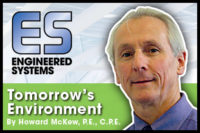In the past, I have written about my experience with people who make a living as marketing and business development (MBD) professionals, and I’ve been a critic of most of them because they don’t want to be associated with selling. To me, selling is No.1 (refer back to my March, 2009 column titled, “The Three-Legged Stool – Part 2”), but no one wants to be labeled a salesperson.
My observation of MBD professionals is that they are always looking at what is out front of them and focused on the coming months relative to potential work and who they should network with to position themselves to get awarded this work. This MBD person isn’t looking “over the horizon” at what the building industry or the HVAC industry will be doing in three or five years from now. To me, the MBD individual should also be allocating time to learning more about how the industry will be functioning and about the opportunities that may arise once they get over the horizon.
TWO EXAMPLES
Here are two examples of events that occurred that most, if not all MBDs never saw coming because they never invested in looking over-the-horizon:-
Outpatient ambulatory
surgery centers (ASCs). Who saw “same-day”
surgery centers being a building industry opportunity back in 1970 when the
first ASC opened in Arizona?
Comment: Just imagine if an HVAC MBD professional had had the foresight to see ASC being such a huge business opportunity, so that her firm would have been positioned to be the leader in ASC design and/or operate and maintain such facilities throughout the country. - Integrated project
delivery (IPD). While professional organizations such as AGC,
AIA, and NSPE struggled to determine the optimum project delivery method (design-bid-build,
construction management, and design-build) from the 1960s up through 2007, IPD
was right over the horizon.
Comment: Today designers and builders are frequently saying, “Oh, yes we do IPD and/or IPD-ish.” These firms are trying to position themselves to be perceived as IPD experienced now that it’s right out there in front of the industry.
Unfortunately, this initiative didn’t take off and was abandoned a few months later. Still, it helped to raise my awareness that there were MBD opportunities over the horizon that, at best, were in their embryonic phases and were available if one was willing to look. A good example of looking ahead and changing how things are done is the “Smart and Sustainable Campus Conference” each year, which focuses on very progressive environmental issues and examples of prototype environmental and energy initiatives solutions.
VISIONARIES
Recently, I was quite impressed with an architectural firm when I was invited to participate in their all-day session titled, “Translation Health Science – Bringing Research to Life.” Here was a topic that had the participants looking over the horizon with a discussion of academic health science centers and the strategies to integrate clinicians, scientists, engineers, and patients.As I listened, it brought me back to that high-profile team-task and reinforced my belief that MBD personnel need to be looking over the horizon to formulate answers to “What If?” and “Why Not?” starting points that may contribute to a company’s continuous success and the perception that it is a progressive firm, the kind people want to work with and work for.
A second MBD strategy is to question a type of traditional HVAC system used, the type of equipment used that would lead an MBD professional in researching and strategizing a better approach that might differentiate the company from the competition.
Back in 1984 I was able to get the dual-fan/double-duct (DF-DD) concept into the 1984 AHSRAE Handbook as a better way to design double duct (DD) systems. It wasn’t too many years later that the conventional DD system was replaced with DF-DD as the standard for health care and research facilities applications.
Later, an engineer said to me that the concept was so simple and asked why didn’t he think of that. If engineering MBD professionals were to transfer the business opportunities on the horizon to sales professionals and take on the role of a visionary, the skilled salesperson would be focused on selling and the MBD would be looking for those opportunities to generate business and separate the company from the competition. Isn’t that what marketing and business development all about? ES



